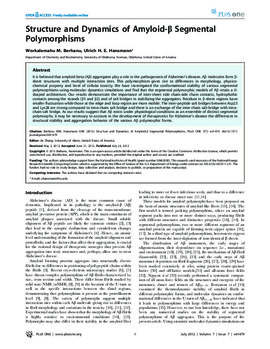| dc.contributor.author | Workalemahu M. Berhanu | en_US |
| dc.contributor.author | Ulrich H. E. Hansmann | en_US |
| dc.date.accessioned | 2015-01-23T17:17:36Z | |
| dc.date.accessioned | 2016-03-30T15:35:32Z | |
| dc.date.available | 2015-01-23T17:17:36Z | |
| dc.date.available | 2016-03-30T15:35:32Z | |
| dc.date.issued | 2012-07-24 | en_US |
| dc.identifier.citation | Berhanu WM, Hansmann UHE (2012) Structure and Dynamics of Amyloid-β Segmental Polymorphisms. PLoS ONE 7(7): e41479. doi:10.1371/journal.pone.0041479 | en_US |
| dc.identifier.uri | https://hdl.handle.net/11244/14076 | |
| dc.description | | en_US |
| dc.description | Conceived and designed the experiments: WB UH. Performed the experiments: WB. Analyzed the data: WB UH. Contributed reagents/materials/analysis tools: WB UH. Wrote the paper: WB UH. | en_US |
| dc.description.abstract | It is believed that amyloid-beta (Aβ) aggregates play a role in the pathogenesis of Alzheimer’s disease. Aβ molecules form β-sheet structures with multiple interaction sites. This polymorphism gives rise to differences in morphology, physico-chemical property and level of cellular toxicity. We have investigated the conformational stability of various segmental polymorphisms using molecular dynamics simulations and find that the segmental polymorphic models of Aβ retain a U-shaped architecture. Our results demonstrate the importance of inter-sheet side chain-side chain contacts, hydrophobic contacts among the strands (β1 and β2) and of salt bridges in stabilizing the aggregates. Residues in β-sheet regions have smaller fluctuation while those at the edge and loop region are more mobile. The inter-peptide salt bridges between Asp23 and Lys28 are strong compared to intra-chain salt bridge and there is an exchange of the inter-chain salt-bridge with intra-chain salt bridge. As our results suggest that Aβ exists under physiological conditions as an ensemble of distinct segmental polymorphs, it may be necessary to account in the development of therapeutics for Alzheimer’s disease the differences in structural stability and aggregation behavior of the various Aβ polymorphic forms. | en_US |
| dc.language.iso | en_US | en_US |
| dc.publisher | PLos One | en_US |
| dc.relation.ispartofseries | PLoS ONE 7(7):e41479 | en_US |
| dc.relation.uri | http://www.plosone.org/article/info%3Adoi%2F10.1371%2Fjournal.pone.0041479 | en_US |
| dc.rights | Attribution 3.0 United States | en_US |
| dc.rights.uri | https://creativecommons.org/licenses/by/3.0/us/ | en_US |
| dc.subject | PLOS | en_US |
| dc.subject | Public Library of Science | en_US |
| dc.subject | Open Access | en_US |
| dc.subject | Open-Access | en_US |
| dc.subject | Science | en_US |
| dc.subject | Medicine | en_US |
| dc.subject | Biology | en_US |
| dc.subject | Research | en_US |
| dc.subject | Peer-review | en_US |
| dc.subject | Inclusive | en_US |
| dc.subject | Interdisciplinary | en_US |
| dc.subject | Ante-disciplinary | en_US |
| dc.subject | Physics | en_US |
| dc.subject | Chemistry | en_US |
| dc.subject | Engineering | en_US |
| dc.title | Structure and Dynamics of Amyloid-β Segmental Polymorphisms | en_US |
| dc.type | Research Article | en_US |
| dc.description.peerreview | Yes | en_US |
| dc.description.peerreviewnotes | http://www.plosone.org/static/editorial#peer | en_US |
| dc.identifier.doi | 10.1371/journal.pone.0041479 | en_US |
| dc.rights.requestable | false | en_US |

